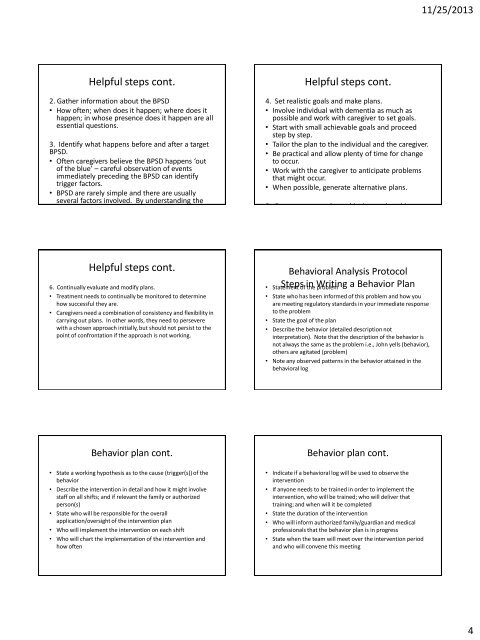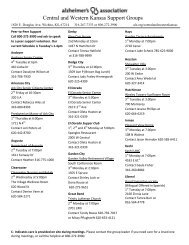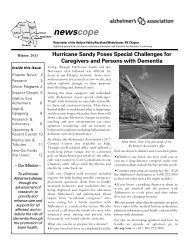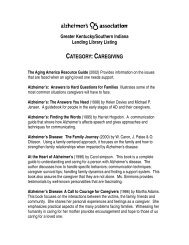First Line Treatment - Alzheimer's Association
First Line Treatment - Alzheimer's Association
First Line Treatment - Alzheimer's Association
You also want an ePaper? Increase the reach of your titles
YUMPU automatically turns print PDFs into web optimized ePapers that Google loves.
11/25/2013<br />
Helpful steps cont.<br />
Helpful steps cont.<br />
2. Gather information about the BPSD<br />
• How often; when does it happen; where does it<br />
happen; in whose presence does it happen are all<br />
essential questions.<br />
3. Identify what happens before and after a target<br />
BPSD.<br />
• Often caregivers believe the BPSD happens ‘out<br />
of the blue’ – careful observation of events<br />
immediately preceding the BPSD can identify<br />
trigger factors.<br />
• BPSD are rarely simple and there are usually<br />
several factors involved. By understanding the<br />
inter-relationship of these factors, the more likely<br />
4. Set realistic goals and make plans.<br />
• Involve individual with dementia as much as<br />
possible and work with caregiver to set goals.<br />
• Start with small achievable goals and proceed<br />
step by step.<br />
• Tailor the plan to the individual and the caregiver.<br />
• Be practical and allow plenty of time for change<br />
to occur.<br />
• Work with the caregiver to anticipate problems<br />
that might occur.<br />
• When possible, generate alternative plans.<br />
5. Encourage reward to achieving goals – this<br />
Helpful steps cont.<br />
6. Continually evaluate and modify plans.<br />
• <strong>Treatment</strong> needs to continually be monitored to determine<br />
how successful they are.<br />
• Caregivers need a combination of consistency and flexibility in<br />
carrying out plans. In other words, they need to persevere<br />
with a chosen approach initially, but should not persist to the<br />
point of confrontation if the approach is not working.<br />
Behavioral Analysis Protocol<br />
Steps in Writing a Behavior Plan<br />
• Statement of the problem<br />
• State who has been informed of this problem and how you<br />
are meeting regulatory standards in your immediate response<br />
to the problem<br />
• State the goal of the plan<br />
• Describe the behavior (detailed description not<br />
interpretation). Note that the description of the behavior is<br />
not always the same as the problem i.e., John yells (behavior),<br />
others are agitated (problem)<br />
• Note any observed patterns in the behavior attained in the<br />
behavioral log<br />
Behavior plan cont.<br />
• State a working hypothesis as to the cause (trigger(s)) of the<br />
behavior<br />
• Describe the intervention in detail and how it might involve<br />
staff on all shifts; and if relevant the family or authorized<br />
person(s)<br />
• State who will be responsible for the overall<br />
application/oversight of the intervention plan<br />
• Who will implement the intervention on each shift<br />
• Who will chart the implementation of the intervention and<br />
how often<br />
Behavior plan cont.<br />
• Indicate if a behavioral log will be used to observe the<br />
intervention<br />
• If anyone needs to be trained in order to implement the<br />
intervention, who will be trained; who will deliver that<br />
training; and when will it be completed<br />
• State the duration of the intervention<br />
• Who will inform authorized family/guardian and medical<br />
professionals that the behavior plan is in progress<br />
• State when the team will meet over the intervention period<br />
and who will convene this meeting<br />
4
















